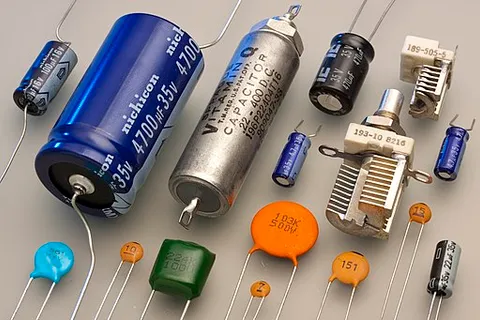Exploring Common Electronic Components
Resistors
Characteristics:
- Resistance (R): Resistors are passive components that impede the flow of electrical current. Resistance is measured in ohms (Ω). A higher resistance value means greater opposition to the current flow.
- Tolerance: Tolerance indicates the allowable variation in resistance from the specified value. Common tolerances include 5%, 1%, and 0.1%.
- Power Rating: It denotes the maximum power the resistor can dissipate without overheating, typically in watts (W).
Uses:
- Voltage Division: Resistors are often used in voltage dividers to create specific voltage levels from a supply voltage.
- Current Limiting: They can limit the current in a circuit, protecting components like LEDs from excessive current.
- Pull-Up and Pull-Down Resistors: In digital circuits, resistors are employed as pull-up or pull-down elements to establish a default logic level.
- Filtering: Resistors are used in conjunction with capacitors to create low-pass and high-pass filters in signal processing.
Common Mistakes for Beginners:
- Incorrect Resistor Value: Beginners may misread or misinterpret the colour bands on resistors, leading to the use of the wrong resistance value.
- Reverse Connection: Connecting resistors backwards in a circuit should not affect its functionality as the resistors are not polarized.
Cure:
- Beginners can use digital multimeters to measure resistor values accurately and double-check connections.
Capacitors
Capacitors are also passive components like resistors but that is the only similarity between capacitors and resistors, apart from that they are quite opposite, capacitors store electrical charges up to their threshold value then they discharge it.
Characteristics:
- Capacitance (C): Capacitors store electrical charge and have a capacitance value measured in farads (F). A higher capacitance means the capacitor can store more charge.
- Voltage Rating: It indicates the maximum voltage a capacitor can handle without breaking down.
- Polarity: Some capacitors are polarized and must be connected with the correct polarity, while others are non-polarized and can be connected in either direction.
Uses:
- Energy Storage: Capacitors store energy and can discharge it rapidly when needed, making them ideal for smoothing power supplies.
- Timing: Capacitors in conjunction with resistors can create timing circuits, like oscillators and time delay circuits.
- Filtering and Decoupling: They filter out noise and stabilize voltage in power supplies.
- Motor Start Capacitors: These provide the initial boost of power needed to start electric motors.
Common Mistakes for Beginners:
- Incorrect Polarity: Connecting polarized capacitors with the wrong polarity can result in capacitor damage or circuit malfunction.
- Mistaken Capacitance Value: Misreading the capacitance value on a capacitor or using the wrong value can lead to circuit issues.
Cure:
- Beginners should pay close attention to the markings on capacitors and be aware of their polarity. Using non-polarized capacitors can help avoid polarity-related errors.
- Some times broken capacitors can also cause the malfunctioning of the overall circuit, I recommend one always use a multi-meter for testing the capacitors
Transistors
Characteristics:
- Types: Transistors come in various types, including bipolar junction transistors (BJTs) and field-effect transistors (FETs).
- Amplification: Transistors can amplify electrical signals. In BJTs, current controls current, while in FETs, voltage controls current.
- Switching: Transistors can act as switches, turning a current on or off based on an input signal.
Uses:
- Amplification: In audio amplifiers, transistors boost weak signals to drive speakers.
- Digital Logic Gates: Transistors form the basis of digital logic gates in computer circuits, enabling complex calculations and operations.
- Signal Modulation: They are used in radio and communication circuits to modulate and demodulate signals.
- Voltage Regulation: Transistors can regulate voltage levels in power supplies.
Common Mistakes for Beginners:
- Wrong Pin Configuration: Incorrectly connecting transistors can reverse or damage their intended functionality.
- Inadequate Biasing: Failing to provide proper biasing to transistors in amplification circuits can result in distortion or low performance.
Cure:
- Beginners should carefully study the datasheets of transistors for correct pin configurations and ensure proper biasing when using them for amplification.
- Reading the datasheet is not a heavy task if done correctly and this helps by making the development easy and saving hours of debugging.
Understanding the characteristics and applications of resistors, capacitors, and transistors is fundamental for anyone interested in electronics. These components are the core elements upon which more complex circuits are built. As you dive deeper into electronics, you'll discover the versatility and importance of these components in various applications, from simple LED circuits to advanced communication systems, the usage of these are very common and crucial, for designing a circuit and debugging it, I will recommend before you start building you circuit on actual hardware try to simulate it on Simulink, Tinker CAD and many other simulation platform, I personally prefer these two but you can use whichever you find more easy for yourself.
So that's all for the basics and starters for exploring the common electronics components, I will be covering some more electronics components in future blogs, Until that time Happy learning





Comments
Post a Comment